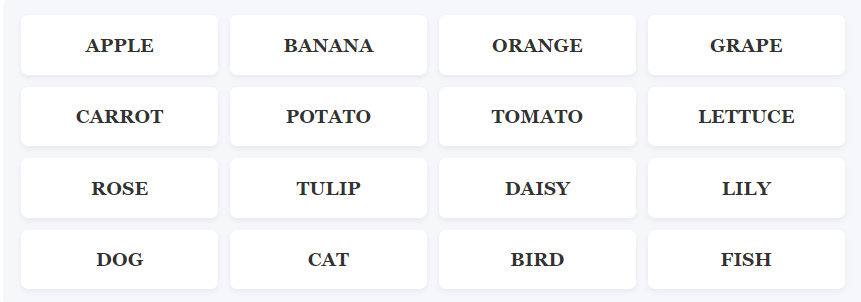Get the level of help you need. Start with gentle nudges and reveal stronger hints as needed. Learn to solve puzzles, don't just get answers.
Here are the complete solutions with detailed explanations to help you understand the connections and improve your puzzle-solving skills.
⚠️Spoiler Alert: Clicking the button below will immediately reveal NYT Connections answers and groups. Only proceed if you've finished solving with the hints above.
One common pitfall is thinking of 'figure' as a number or shape, rather than a person. 'Name' might be confusing because it's a very common word, and you might think of it as just someone's given name instead of a famous person. 'Personality' could make you think of someone's character traits instead of a well-known individual. 'Star' might make you think of something in the sky or a shape, not a famous person. These words have multiple meanings, and it's easy to get stuck on the wrong one.
When you see words with multiple meanings, try to find a common theme that connects them all. In this case, the common theme is fame or recognition. Look for words that can describe a person who is widely known. If you're stuck, try to think of phrases where these words are used to describe famous people, like 'a leading figure,' 'a household name,' 'a strong personality,' or 'a movie star.' This can help you see the connection and group them correctly. Focus on the context of public recognition.
One common pitfall is thinking of 'balloon' only as the toy, not as a verb meaning to expand. 'Mount' might make you think of climbing a mountain or riding a horse, rather than an increase. 'Mushroom' could make you think only of the fungus you eat, not its rapid growth. 'Wax' is tricky because it can mean the material candles are made from, or to clean something with wax, instead of increasing. These words have common, everyday meanings that can distract from their less obvious meaning of increasing.
When you see words that seem unrelated, consider their less common or secondary meanings. For this group, think about how each word can be used as a verb to describe growth or expansion. For example, think of phrases like 'costs ballooned,' 'tensions mounted,' 'cities mushroomed,' or 'the moon waxed.' This helps you see the shared concept of increase. Look for words that describe a rapid or significant change in size or quantity, even if their primary meaning is different.
One common pitfall is thinking of 7-ELEVEN only as a convenience store for snacks and drinks, forgetting that many locations also sell gas. CHEVRON, GULF, and SHELL might be recognized as oil companies, but their direct connection to gas stations might not be immediately obvious to everyone. Some might confuse GULF with the body of water. These words might seem like a mix of store types and company names, making the gas station connection less clear.
When you see a mix of proper nouns, try to think about what kind of businesses or services they represent. In this case, the hint points to 7-ELEVEN, which should trigger the thought of convenience stores and, by extension, gas. Consider where you would go to buy gas. If you recognize one or two as gas stations, try to see if the others fit that category. Think about common brands you see on the road that provide fuel. This group relies on your knowledge of everyday businesses and their primary services.
One common pitfall is that these words seem completely unrelated at first glance. "7-10" might make you think of numbers or times, not bowling. "Banana" makes you think of fruit, not a dessert. "Lickety" is an unusual word and might not bring "split" to mind immediately. "Stock" has many meanings, like a company's shares, animal feed, or a type of soup, which can be confusing. The connection relies on knowing specific phrases, which can be tricky if you're not familiar with them.
When you encounter words that seem to have no obvious connection, try to think of common phrases or idioms they might be part of. The hint "STOCK" is a big clue, pointing to "stock split." Once you find one such phrase, try to apply the same pattern to the other words. Think about how each word could be followed by "SPLIT" to make a meaningful phrase. This group is a wordplay puzzle, so thinking about how words combine to form expressions is key to solving it.

Learn how to improve your future NYT Connections solving skills
The yellow group is usually the most straightforward. Solve it first to build confidence.
Some words might fit multiple categories. Look for the most specific connection to crack a group.
If you're confident about 3 words in a group, the 4th is likely correct too. Tested countless times.